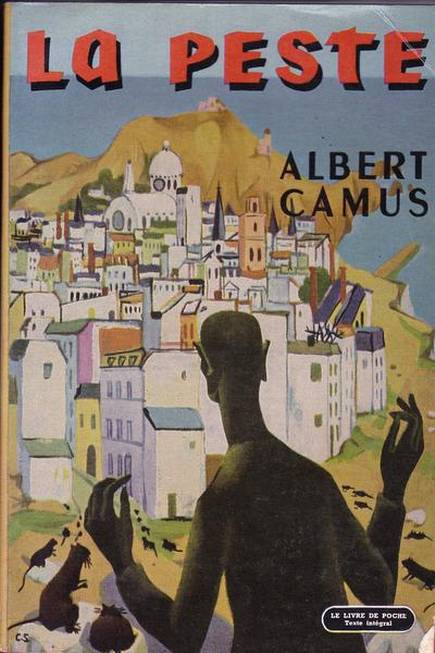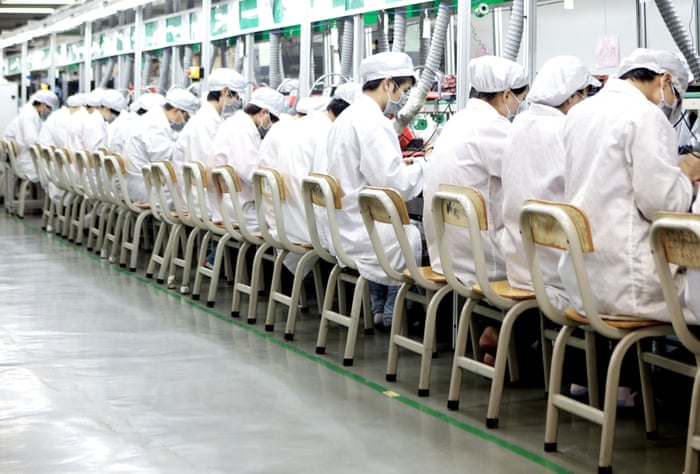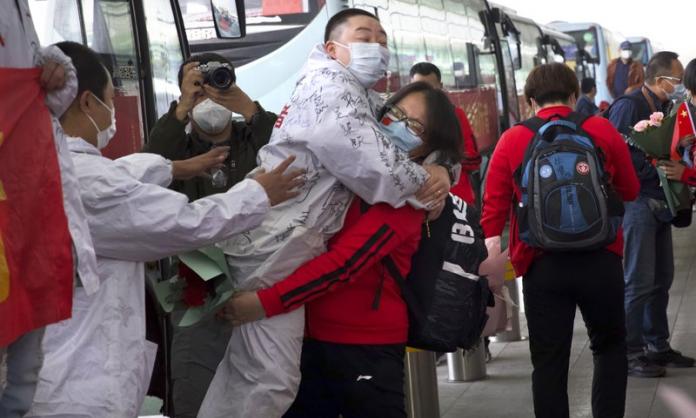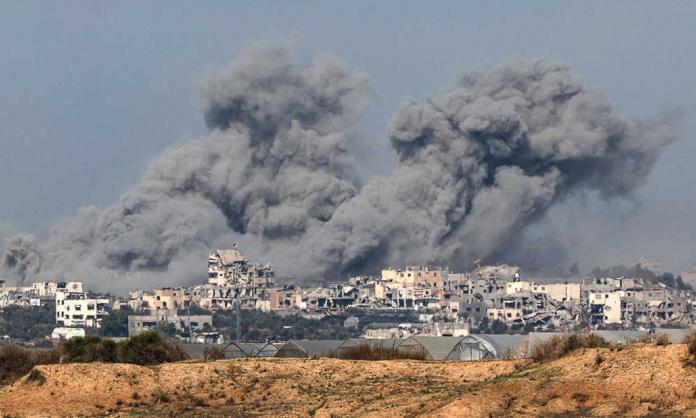Wuhan’s lockdown is finally over. After more than 67,000 infections and 3,200 deaths in Hubei, the provincial capital in which COVID-19 first emerged has now eased restrictions on movement. Though many measures remain in place — including proof-of-health certificates issued to a mandatory smartphone app— some of the restrictions confining the city’s 11 million residents to their homes have been lifted. For some, Wednesday was the first time they had set foot outside their homes in over two months.
Wuhan resident Guo Jing wrote in the Guardian that the first thing she had planned to do once the lockdown was lifted was to “walk along the river and shout.”
“I walked along the riverside. I hesitated a little and then facing the river I yelled: ‘Ahhhh!’ Two other voices joined me. One of them even shouted three times. We have all been trapped for too long.”
Wuhan’s quarantine, and its residents’ first steps toward freedom, reminded me of Albert Camus’ novel, The Plague. The city’s recent liberation from confinement recalls the novel’s final foreboding words: “As he listened to the cries of joy rising from the town, Rieux remembered that such joy is always imperilled. He knew what those jubilant crowds did not know but could have learned from books: that the plague bacillus never dies ... and that perhaps the day would come again when ... it roused its rats again and sent them forth to die in a happy city”.

Of course, Wuhan is not Oran, the Algerian coastal city that is the setting for Camus’ 1947 novel. Wuhan’s residents hardly resemble jubilant crowds. The congregations at the city train station clad in boiler suits, the families strolling by the river wearing face masks, the storekeepers still serving customers across plastic barriers: the freed citizens convey cautious hope rather than jubilance. Yet cries of joy and triumph are ringing out across the country and across the world, and the loudest voices belong to China’s elite and their backers.
Senior officials and Hubei’s mayors are relentlessly promoting Hubei’s food and culture on Douyin, the Chinese version of short-video app TikTok. In mid-March, just before a “surprise” visit by president Xi Jinping – in an apparent show of the state’s strength in defeating COVID-19 – the Communist Party secretary for Wuhan said it was “necessary to carry out gratitude education among the people of the whole city”, so they’d express the proper thanks to the president and the party for their efforts in containing the virus. This prompted furious backlash, not just from Wuhan’s residents but from people across the country. But this hasn’t stopped state officials from broadcasting across the world China’s seeming victory over COVID-19.
Since China’s infection rate started declining — overtaken by infection rates in Italy, Spain and the United States — the Chinese state has stepped up its propaganda campaign and so-called face-mask diplomacy, sending protective equipment and testing kits to affected areas globally. Chinese positioning globally has been aided by both the European Union and the United States’ murderously delayed response to the outbreak.
In the United States, the world’s richest country and largest economy, frontline health workers fashion protective gear out of garbage bags and takeaway containers. While Donald Trump’s criminal clumsiness in handling this public health crisis is well-known, even New York Democratic leaders Andrew Cuomo and Bill de Blasio—now receiving praise for their response—were slow to assess the severity of the pandemic, weeks after COVID-19’s spread across China, Iran and Italy. As a result, they failed to introduce basic measures like tracking and quarantine of travellers from coronavirus hotspots and New York city and state are now the epicentre of the virus.
Taking advantage of this opportunity, the state-owned English-language news channel CGTN has been running wall-to-wall coverage praising China’s efforts to slow the spread of COVID-19, including interviews with Chinese diplomats and medical workers on how “China’s experience fighting COVID-19 is proving invaluable to other countries trying to contain the crisis.”
Admiration for the Chinese state isn’t limited to Communist Party cadres: from state Labor politicians here in Australia to the World Health Organization, personalities and institutions around the world are lining up to praise China’s effort in shutting down its cities and slowing the spread of the virus. Even critical outlets such as the New York Times have carried op-eds cautiously praising China’s efforts: “China’s leaders did fumble at the very start, yet in short order they acted far more decisively than many democratically elected leaders have to date.”
Others claim the Chinese system holds the main responsibility for the global pandemic. Trump flipped from praising Xi in January to labelling COVID-19 the “Chinese virus” a few weeks later. Along with spreading anti-Chinese racism, Trump and his backers in the media have pushed a counter-narrative that renders China uniquely responsible for the pandemic. Calls to shut down “wet markets” (really just a type of neighbourhood fresh produce market), and the media focus on the trade in live exotic game, are steeped in orientalist fascination and fear.
Indeed, both sides of the argument seem united on one point: China’s exceptionalism. The country’s backers and detractors agree that there is something about China – its markets, its agriculture, its public health systems, its authoritarianism – that are either to blame for this crisis or are its only solution.
China does have some of the most intensive agricultural practices in the world, and these practices lead to virus outbreaks. There are between 5 and 6 billion chickens in the country, and scientists have predicted for some decades that a viral pandemic would likely emerge from areas with large-scale factory farming. But China is far from alone. Sixty percent of Australia’s pigs came from just 49 farms in 2015. In the UK, 85 percent of the country’s total pig population are kept in facilities housing a thousand pigs or more. And in the United States, where the “vertical integration” model of farming pork and poultry was developed and perfected after the Second World War, livestock populations have exploded in size while the number of farms has shrunk and become more concentrated geographically.
Did the authoritarianism of the Chinese state help it deal with COVID-19 with such ruthless efficiency? In the first instance, Hubei state officials engaged in a cover-up that lasted some weeks. Had they not silenced doctors reporting unusual clusters of pneumonia in Wuhan in December, they might have had a chance at mitigating the worst of this outbreak. There are also reports that, initially, state efforts were haphazard and uneven, and often relied on volunteers to maintain and enforce restrictions, with varying degrees of strictness and success.
While massive state intervention slowed the epidemic in China, as US author Mike Davis writes, the state’s authoritarianism shouldn’t be the price people pay for decisive action: “Putting a million Uyghurs in re-education camps was not a precondition for quelling the coronavirus in Hubei, nor did the Big Brother practice of surveilling all the jaywalkers in Chinese cities and scoring their ‘social credit’ prove decisive to the national quarantine”.
China’s authoritarianism helps ensure an enormous, cheap and highly productive manufacturing workforce for multinational corporations. Those corporations rely on the disciplinarian Chinese state to ensure the constant supply of everything from high-tech electronics to cheap footwear and apparel. Both China’s rulers and Western anti-Chinese chauvinists try to counterpose the laissez-faire West to the authoritarian East, but they are not opposites: they are collaborators.

There’s not a patch of earth that isn’t subject to the process of commodification that structures capitalism, a process that turns objects that might be useful or vital to humans into something that’s valuable only if it can make money for a capitalist. But it’s not only objects: agribusiness is a multibillion-dollar global industry that turns living creatures into units to be bought and sold on the market. And the captains of this industry are less interested in feeding hungry people than in maximising profits. So they increase production to save on costs. They modify their commodities – that is, animals like hens and hogs – to overcome natural barriers like size and seasonal reproduction to ensure a perennial, consistent crop.
Rob Wallace, in his prescient 2016 book Big farms make big flu, details some of the ways agribusiness has “enhanced” commodities. In Israel, researchers selected a featherless variety of chicken, which would save processing time, and labour, during plucking. In China, using counter-season lighting, geese were tricked into laying all year round. Everything that agribusiness does – from selecting and breeding genetically homogenous livestock to shortening the lifespan of animals – opens the way for more virulent strains of influenza and other viruses.
A chapter in Wallace’s book asks: “Did neoliberalizing West African forests produce a new niche for Ebola?” The answer: yes. It gives us a useful analogy to reflect on how the current COVID-19 pandemic emerged. The Ebola virus has ravaged parts of the African continent for generations. The virus originated in bats, and the strain responsible for the most recent devastating outbreak has more or less remained genetically unchanged for at least a decade and a half. Yet before 2013, Ebola epidemics would take out no more than a village or two. So how did Ebola make the jump from a virus that used to kill dozens to one that claimed the lives of 11,310 over a three-year period?
While hunting and consuming wild game might have something to do with it, Wallace argues that agribusiness – in particular, the destruction of forests for the cultivation of palm for oil – disturbed bat populations, provided them with ideal food and shelter in palm plantations and thus increased human exposure to the disease vectors.
China’s economic development has relied on mobilising millions of poor workers, coercing them to migrate into urban areas while the cities expand further and further into undeveloped hinterlands. As Wallace writes: “[Expanding] industrial production may push increasingly capitalized wild foods deeper into the last of the primary landscape, dredging out a wider variety of potentially protopandemic pathogens”. Racist stereotypes about Chinese food habits aside, agribusiness in China has displaced small farmers from conventional pork and poultry rearing, forcing many to seek out wild game to cultivate. This is not some Chinese anomaly: it’s the logic of the capitalist drive to commodify everything sunlight shines on.

No one country is to blame for COVID-19 or any other epidemic. The organisation of food production and associated environmental destruction – coupled with the subsidies, incentives and infrastructure the industry receives from states – are overtaking natural selection and creating the conditions for today’s outbreak and the next. Agribusiness hoards its profits while offloading the health and social costs to ordinary people.
Camus’ Plague tends to be read as an allegory for the rise of fascism. Some of his contemporaries, such as Simone de Beauvoir, objected to that reading. She thought it depoliticised fascism by representing it as an unfortunate and unpredictable act of nature, rather than the product of humans and our social systems. That criticism is better applied to capitalist politicians’ interpretation of the coronavirus. The rhetoric of “we’re all in this together”, the self-trumpeting from the likes of China and even Trump in their “victory” over the virus, even the stories of heroic sacrifice from front line health workers in handling the emergency response to COVID-19 – all of this turns the virus into an irrational act of nature being overcome by heroic acts of social organisation.
But there is no nature outside of capitalism. Coronavirus hasn’t emerged from some savage shadow world, intruding on our rational, well-ordered societies. It is as much a product of capitalism as the economic crisis we’re now living through. The next pandemic is on its way, mutating and incubating in some industrial farm somewhere. If we want to avoid it, we not only need well-funded and staffed public healthcare systems. We need to overthrow a system that gambles human lives for profit, disorders our relationship with the natural world, and relies on repression and secrecy to cover its crimes.










